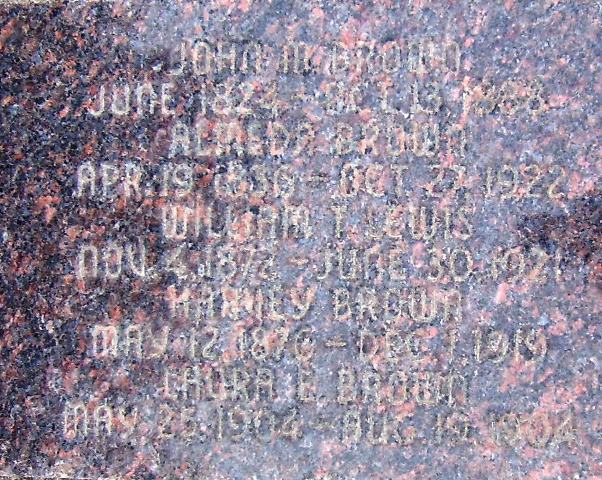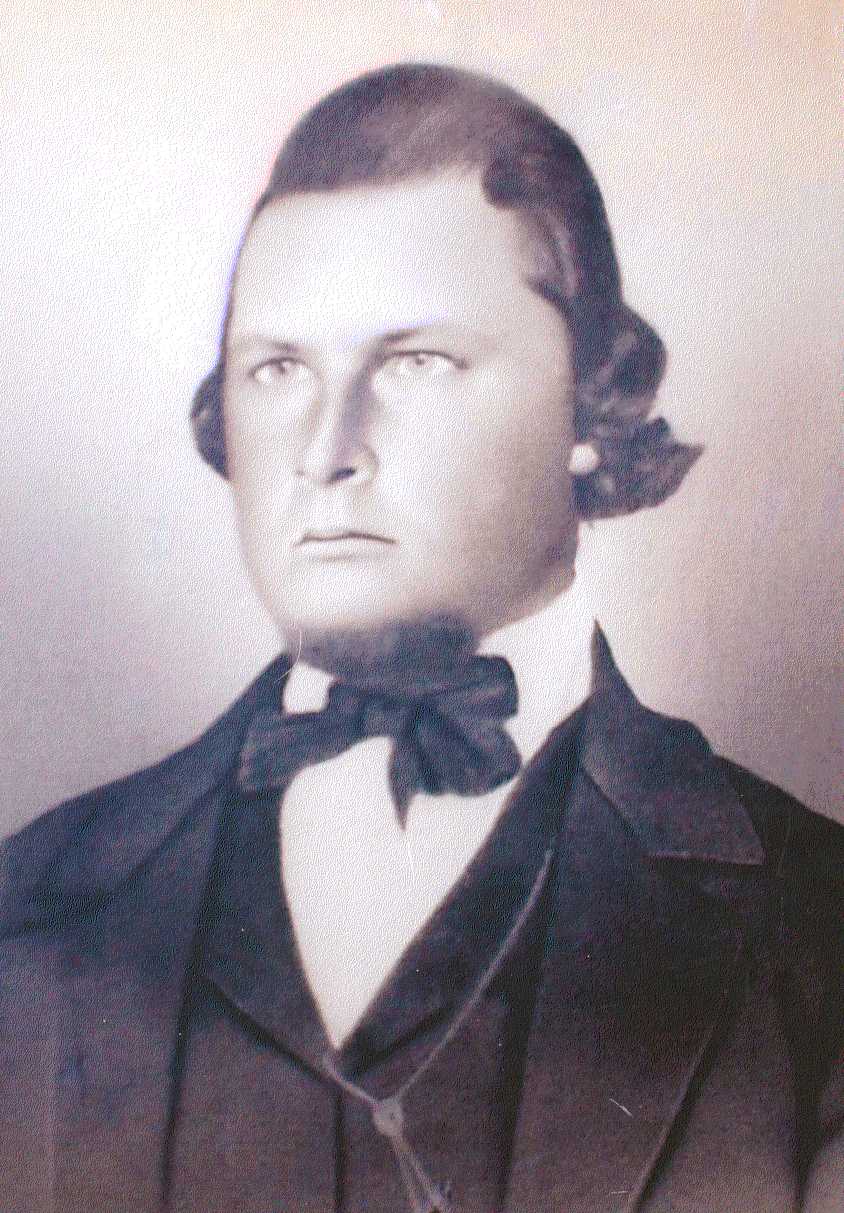Married:
Nancy Ann Foutz, 25 Jan 1841, Nauvoo, Hancock, IL
Lovina Wilson, 23 Oct 1854, Ogden, Weber, UT
Louise Ann Wilson, 23 Oct 1854, Ogden, Weber, UT
Almeda Wilson, 23 Oct 1864, Ogden, Weber, UT
BIOGRAPHY OF JOHN MARTIN BROWN I
John Martin Brown the eldest son of Capt. James Brown and Martha Stephens Brown, was born June 29, 1824 in Rowan County, North Carolina. There were eight sons and one daughter in the family. He lived at this place, working on his father's farm and helping to make hemp rope, until he was nine years of age. In 1833 the family came to Brown County, Illinois, a thousand mile journey, which was made with horses and wagons. His father being a school teacher it was under his teachings that John learned the rudiments of reading and writing.
After living in Brown County two years, the family moved to Adams County, Ill., where his father entered into farming on a large scale. This new country and the land had to be cleared of timber before it could be cultivated. This was accomplished by girdling the trees so they would die, then cutting them down and putting them in piles then burning them. After this land was cultivated and crops were grown the produce was shipped to Quincy, Ill. on the Mississippi River.
Wild meat, such as deer, wild turkey, partridge, possum, coon, quail and wild hogs were plentiful. Therefore, it was from this supply that they were able to obtain fresh meat for summer and dried meat for their winter use. In this part of the country were salt licks, left from the receding of an ancient sea, and it was here that the deer would go to drink and get salt and this made it convenient for the hunters. They also made bird traps from small poles to catch wild turkey. They would leave a string of corn leading to the trap and the turkey would eat the corn finally falling into the trap.
After the land was cultivated and they had raised sufficient corn to feed hogs they raised domesticated ones, but it was necessary to keep them penned to keep the wild hogs from killing them. It was also necessary to watch the pens at night and keep fire brands burning to keep away prairie wolves. At times they drove large turtles into brush fires and roasted them. At one time they caught one and raised it in the swill barrel.
During the summer the hogs were turned out in the forest and fed on nuts in the weeds, which consisted mostly of oak and hazel brush. In the evening they fed them corn. At feeding time they managed to get them home by calling in a loud voice "pig-ooh" and soon they would hear the pigs grunt and here they would come running for their corn.
Their home was a log cabin, such as Daniel Boone lived in. On their farming they raised corn, sweet potatoes, pumpkins and beans. They were very glad when they were able to raise these luxuries, as they got tired of living on wild meat.
It was necessary to travel ten to fifteen miles on horse back with saddle bags over a rough crooked road in order to get the corn to the mill to have it ground into corn meal. This would take one or two days, as the only mills available were hand mills. The miller received his pay by taking his toll of corn.
His mother always milked the cow and when she was confined to bed with a new baby the lot fell to John M. now a boy of fourteen or fifteen years of age. He put on his mother's dress and sunbonnet, thinking he would fool the cow, but when she saw him she ran away. One event he remembered well was the death of his mother. They lived in a log cabin which had a loft of plank floor where dried fruit was kept. His mother died of childbirth and he said at the time he heard beautiful singing, which seemed to come from the loft. This was in Sept. 28, 1840.
In the spring of 1836, after the Mormons had been expelled from Missouri and had begun to settle in Illinois, his parents heard the gospel preached and soon there after were converted and all the family was baptized in 1838.
Married:
Nancy Ann Foutz, 25 Jan 1841, Nauvoo, Hancock, IL
Lovina Wilson, 23 Oct 1854, Ogden, Weber, UT
Louise Ann Wilson, 23 Oct 1854, Ogden, Weber, UT
Almeda Wilson, 23 Oct 1864, Ogden, Weber, UT
BIOGRAPHY OF JOHN MARTIN BROWN I
John Martin Brown the eldest son of Capt. James Brown and Martha Stephens Brown, was born June 29, 1824 in Rowan County, North Carolina. There were eight sons and one daughter in the family. He lived at this place, working on his father's farm and helping to make hemp rope, until he was nine years of age. In 1833 the family came to Brown County, Illinois, a thousand mile journey, which was made with horses and wagons. His father being a school teacher it was under his teachings that John learned the rudiments of reading and writing.
After living in Brown County two years, the family moved to Adams County, Ill., where his father entered into farming on a large scale. This new country and the land had to be cleared of timber before it could be cultivated. This was accomplished by girdling the trees so they would die, then cutting them down and putting them in piles then burning them. After this land was cultivated and crops were grown the produce was shipped to Quincy, Ill. on the Mississippi River.
Wild meat, such as deer, wild turkey, partridge, possum, coon, quail and wild hogs were plentiful. Therefore, it was from this supply that they were able to obtain fresh meat for summer and dried meat for their winter use. In this part of the country were salt licks, left from the receding of an ancient sea, and it was here that the deer would go to drink and get salt and this made it convenient for the hunters. They also made bird traps from small poles to catch wild turkey. They would leave a string of corn leading to the trap and the turkey would eat the corn finally falling into the trap.
After the land was cultivated and they had raised sufficient corn to feed hogs they raised domesticated ones, but it was necessary to keep them penned to keep the wild hogs from killing them. It was also necessary to watch the pens at night and keep fire brands burning to keep away prairie wolves. At times they drove large turtles into brush fires and roasted them. At one time they caught one and raised it in the swill barrel.
During the summer the hogs were turned out in the forest and fed on nuts in the weeds, which consisted mostly of oak and hazel brush. In the evening they fed them corn. At feeding time they managed to get them home by calling in a loud voice "pig-ooh" and soon they would hear the pigs grunt and here they would come running for their corn.
Their home was a log cabin, such as Daniel Boone lived in. On their farming they raised corn, sweet potatoes, pumpkins and beans. They were very glad when they were able to raise these luxuries, as they got tired of living on wild meat.
It was necessary to travel ten to fifteen miles on horse back with saddle bags over a rough crooked road in order to get the corn to the mill to have it ground into corn meal. This would take one or two days, as the only mills available were hand mills. The miller received his pay by taking his toll of corn.
His mother always milked the cow and when she was confined to bed with a new baby the lot fell to John M. now a boy of fourteen or fifteen years of age. He put on his mother's dress and sunbonnet, thinking he would fool the cow, but when she saw him she ran away. One event he remembered well was the death of his mother. They lived in a log cabin which had a loft of plank floor where dried fruit was kept. His mother died of childbirth and he said at the time he heard beautiful singing, which seemed to come from the loft. This was in Sept. 28, 1840.
In the spring of 1836, after the Mormons had been expelled from Missouri and had begun to settle in Illinois, his parents heard the gospel preached and soon there after were converted and all the family was baptized in 1838.
Family Members
-
![]()
CPL Alexander Brown
1826–1910
-
![]()
Pvt Jesse Sowell Brown
1829–1905
-
![]()
Nancy Brown Sanford
1830–1895
-
![]()
Daniel Brown
1832–1864
-
![]()
James Morehead Brown
1834–1924
-
![]()
William Brown
1836–1904
-
Benjamin Franklin "Frank" Brown
1838–1864
-
![]()
Moroni Brown
1840–1916
-
Alma Foutz Brown
1842–1842
-
![]()
James Harvey Brown
1846–1912
-
![]()
Mary Eliza Brown Critchlow
1847–1903
-
![]()
Esther Ellen Brown Dee
1849–1893
-
![]()
Mary Ann "Polly" Brown Leonard
1853–1927
-
Phoebe Adelaide Brown Snyder
1855–1930
-
![]()
Charles David Brown
1856–1926
-
![]()
Joseph Smith Brown
1856–1903
-
![]()
Josephine Vilate Brown Newman
1858–1917
-
![]()
James Fredrick Brown Sr
1859–1923
-
![]()
Augustus Hezikiah Brown
1862–1916
-
![]()
Orson Pratt Brown
1863–1946
-
![]()
Jacob Henry Brown
1847–1910
-
![]()
Elma Brown Hyland
1859–1917
-
![]()
John Martin Brown II
1860–1938
-
![]()
Louisa Brown Stone
1861–1898
-
![]()
Alvin Brown
1863–1945
-
![]()
Mary Ann Brown Wilson
1865–1901
-
![]()
Nancy Ann "Honey" Brown Young Martin Hawkins
1865–1934
-
![]()
Andrew Jackson Brown
1867–1888
-
![]()
William Brown
1868–1939
-
![]()
Lovina Brown Firkins
1870–1944
-
![]()
Caroline Brown Madsen
1873–1929
-
![]()
Eveline Brown Sibbett
1874–1908
-
![]()
Charles Brown
1874–1960






































